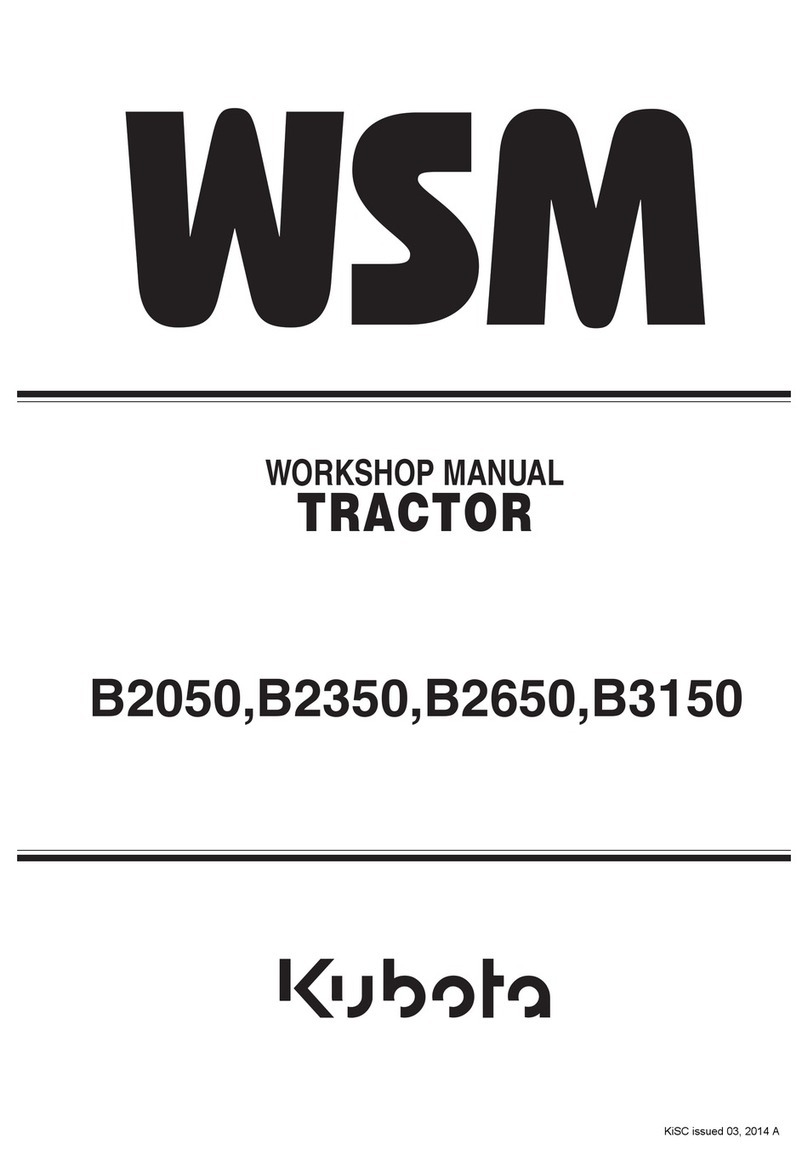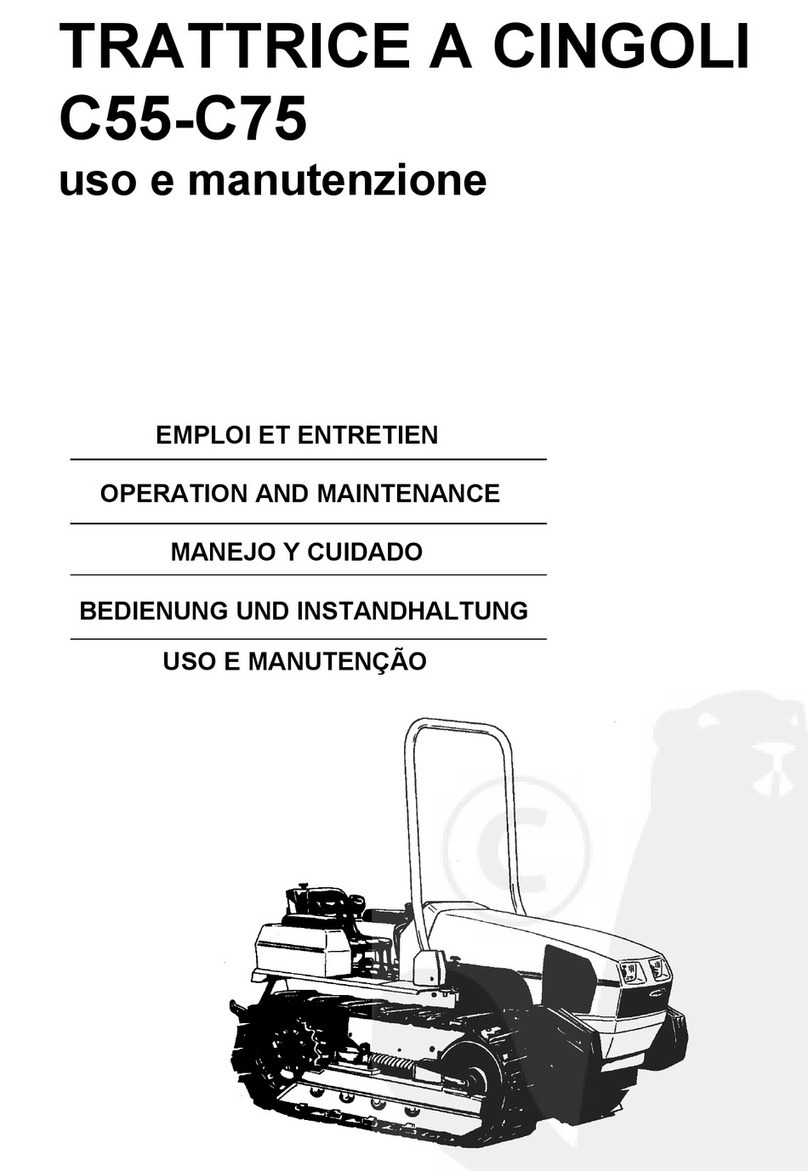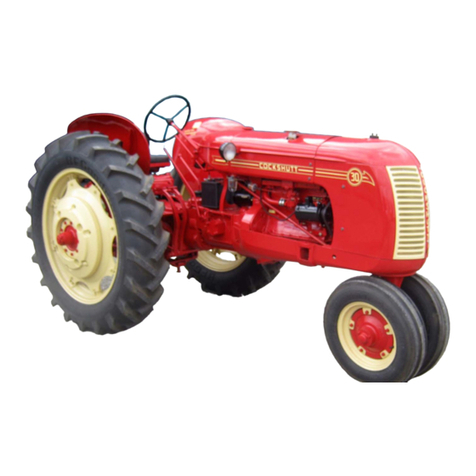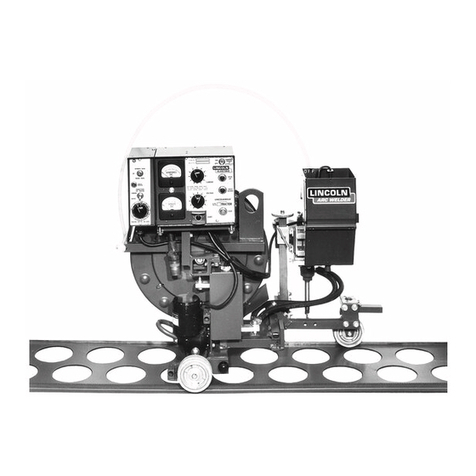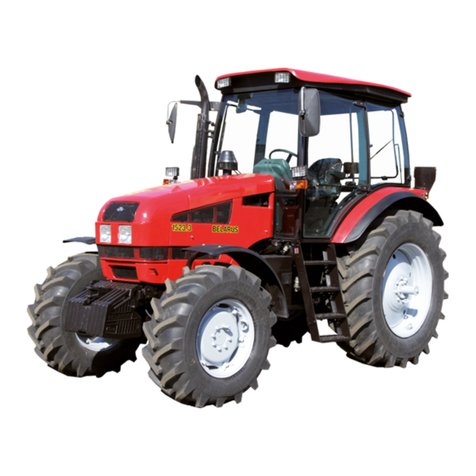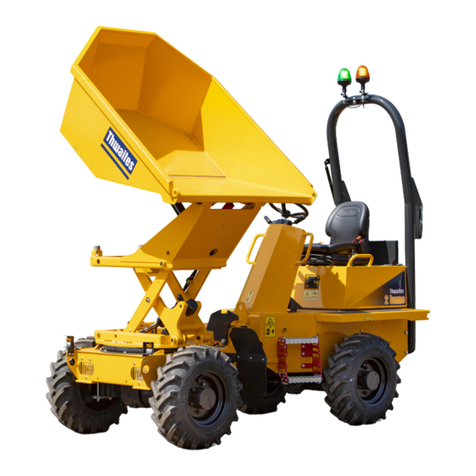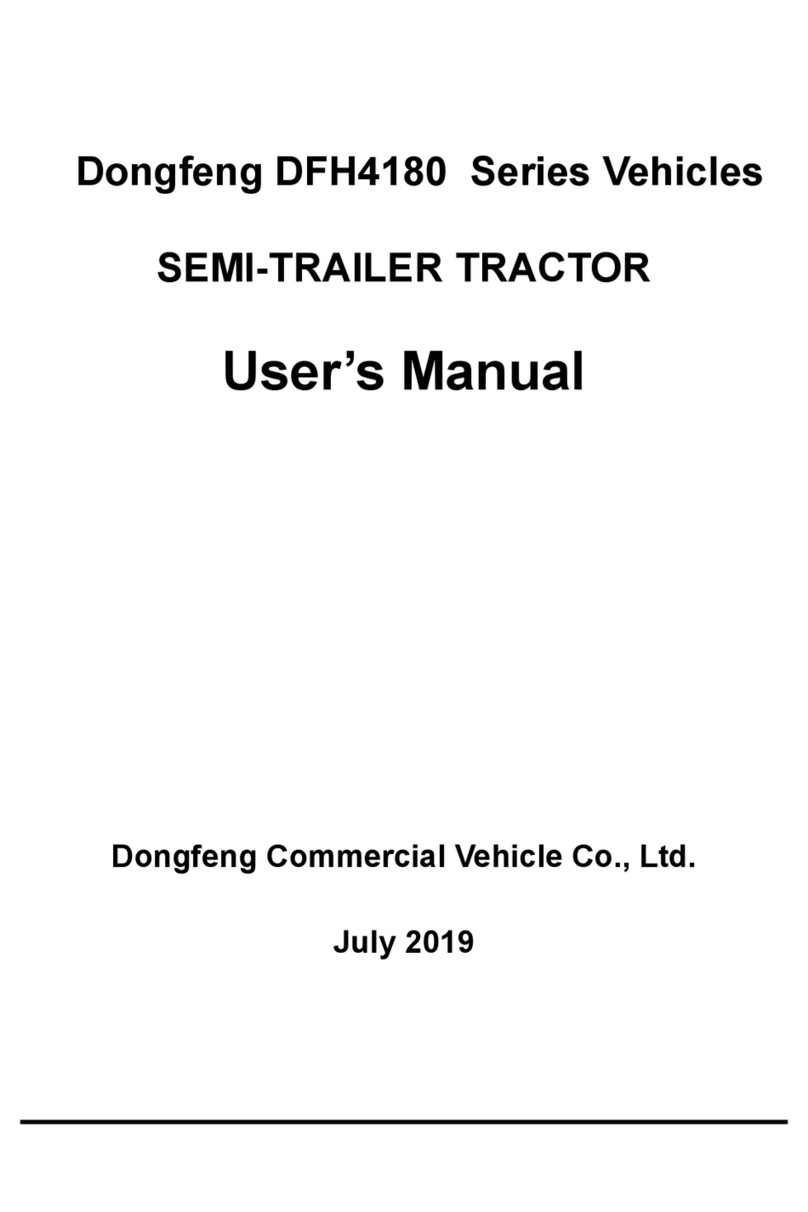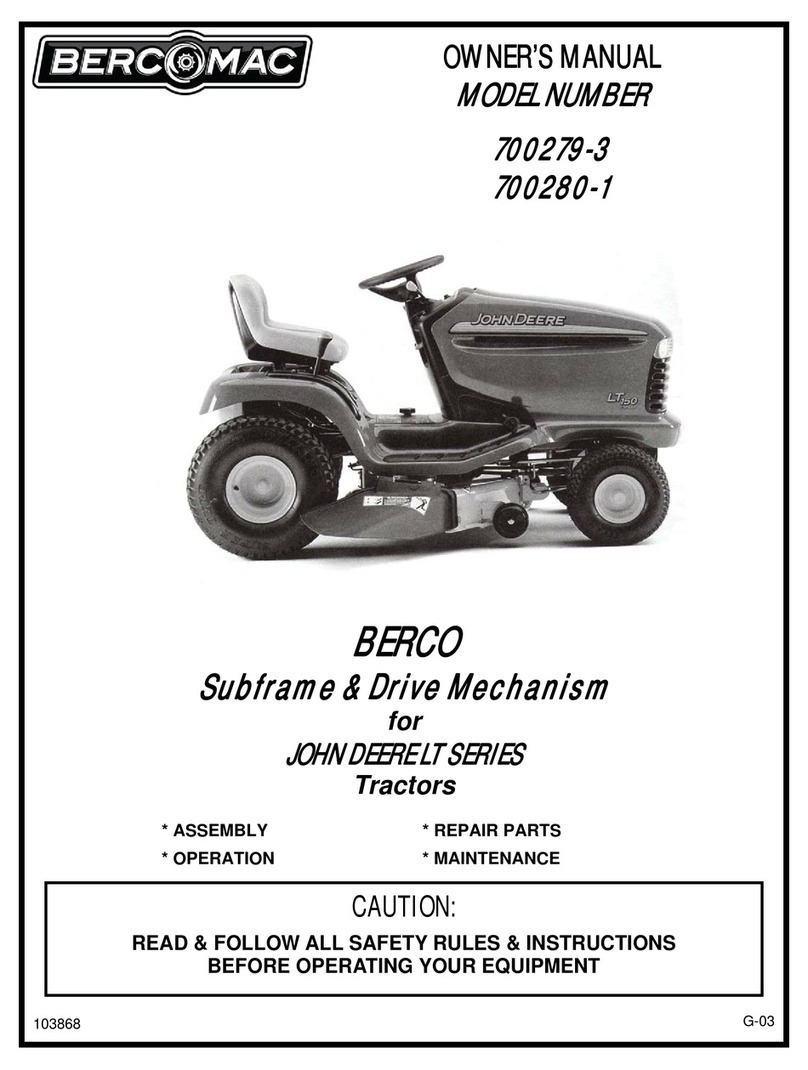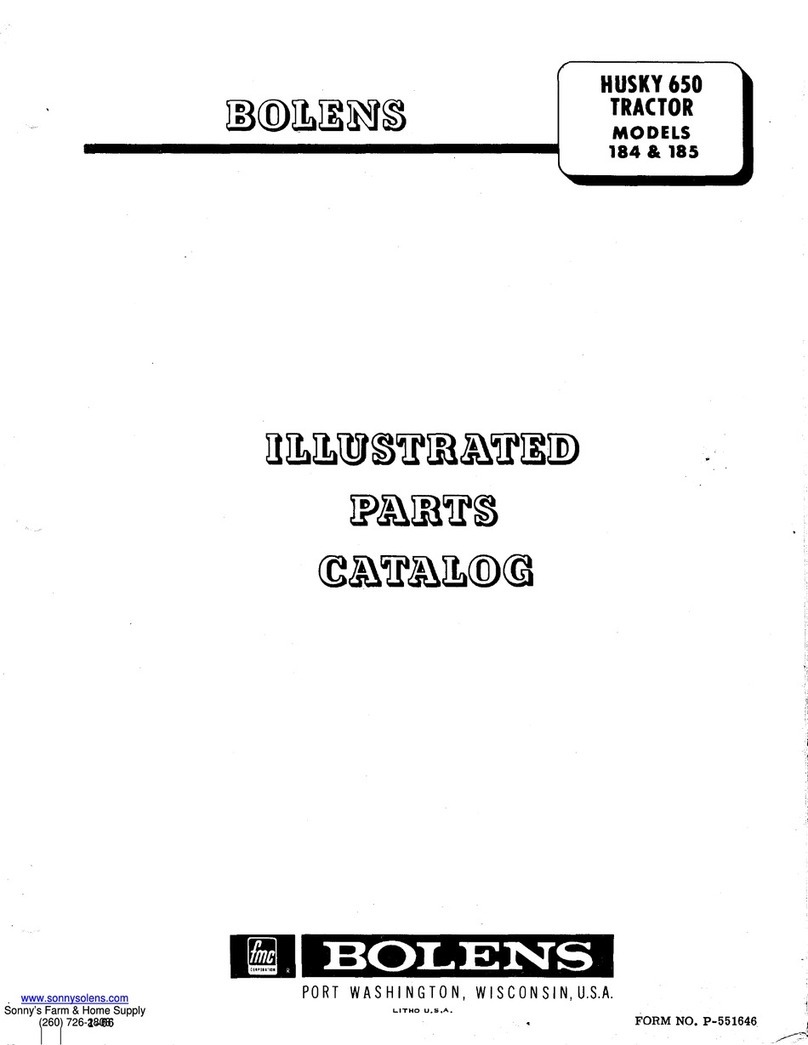MCCORMICK GM 40 T3 User manual

1
TABLE OF CONTENTS
TRACTOR IDENTIFICATION
INTRODUCTION, WARRANTY
SAFETY NOTES
INSTRUMENTS AND CONTROLS
OPERATION
ROUTINE MAINTENANCE
SPECIFICATIONS
ALPHABETICAL INDEX
2
3
4
6
7
SECTION
5
1
Operation and maintenance manual
GM
Argo Tractors S.p.A.
42042 Fabbrico [RE] Italia
via G. Matteotti, 7
t. +39.0522.656111 - f. +39.0522.656476
www.argotractors.com
ORIGINAL INSTRUCTIONS
Valid for tractors equipped with
cab or ROPS models:
Publication N. 6502 084M1
Release 12/2009
GM 40 T3
GM 45 T3
GM 50 T3
GM 55 T3

2
CALIFORNIA
Proposition 65 Warning
Diesel engine exhaust and some of its
constituents are known to the State of
California to cause cancer, birth
defects, and other reproductive harm.
WARNING: If the tractor is fitted with a cab that is not
approved by the tractor’s maker, the warranty
concerning the modified functional units becomes null
and void (safety frame, electric and hydraulic systems,
etc.). Further, it is not possible to check for compliance
with noise level standards and with technical
approvals.
This manual was compiled in compliance with the the ISO 3600 standards and the here contained
instructions comply the requirements of the Machinery Directive 2006/42/EC in force in the European
Community. For tractors sold or used outside the European Community, local laws will prevail.
Main protections on the tractors discussed in this manual.
FOOTSTEP CAB
ROPS (protection against overturning) YES YES
FOPS (protection against objects falling from above) NO NO
OPS (protection against penetration of objects from sides) NO NO
Protection against hazardous chemicals CLASS 1 CLASS 1
This operation and service manual is valid for all countries and all models. It contains photos, notes and directions
both for standard and optional equipment. Therefore it can give details for parts not installed on your tractor with
respect to the local laws in force and according to ordered optional equipment.
The tractor is supplied complete with safety devices according to national or international laws. For your own safety,
please always use correctly such devices and check them for function. If you have any doubts concerning their
operation or use, do not hesitate to ask your Dealer for details.

3
1
Table of contents Page n.
Section 1 Contents ................................................................................................... 3
Tractor identification ................................................................................. 6
Introduction ............................................................................................... 7
Warranty, pre-delivery inspections and installation .................................. 7
Warranty claim ......................................................................................... 7
Spare parts warning ................................................................................. 8
If you move ............................................................................................... 8
Post-warranty service ............................................................................... 8
Safety ....................................................................................................... 8
Section 2 Safety Notes ............................................................................................. 9
Regular use .............................................................................................. 9
Safety alert symbols and terms ............................................................. 10
Safety - tractor and implement ............................................................... 10
Safety - Introduction ................................................................................ 10
Safety - Advice for the operator .............................................................. 10
Safety - Danger, Warning and Caution ................................................... 11
Safety - Decals ....................................................................................... 11
Safety - Following a safety program ...................................................... 11
Safety frame ........................................................................................... 12
Safety - Cab ............................................................................................ 12
Safety precautions .................................................................................. 13
Check your equipment ........................................................................... 15
Cleaning the tractor ................................................................................ 16
Save the environment ............................................................................. 16
Safety - Tractor maintenance .................................................................. 16
Safety - Starting up ................................................................................. 17
Working in safety .................................................................................... 19
Correct manoeuvres ............................................................................... 19
Working in safety .................................................................................... 19
Beware of other people .......................................................................... 20
Risk of overturning .................................................................................. 21
To avoid side overturning ....................................................................... 21
To avoid back overturning ....................................................................... 23
Dangerous operations ............................................................................ 25
Implements and attachments ................................................................ 26
Road transport ....................................................................................... 27
Road circulation rules ............................................................................. 27
Safety - After use .................................................................................... 28
Additional notes ..................................................................................... 29
Risks from noise .................................................................................... 31
Positions of safety decals - All markets ................................................. 32
Section 3 Controls .................................................................................................. 38
Seat ........................................................................................................ 39
Bonnet .................................................................................................... 40
Instrument panel .................................................................................... 41
Symbols on instrument panel................................................................. 41
Controls on the dashboard ..................................................................... 43
Tractor access ........................................................................................ 44

4
Table of contents Page n.
Section 4 Operation ................................................................................................ 45
Starting and stopping the engine ........................................................... 46
Starting the tractor .................................................................................. 47
Clutch operation ..................................................................................... 47
Gearbox operation .................................................................................. 48
Power take-off ........................................................................................ 50
Brakes .................................................................................................... 53
Differential lock ....................................................................................... 54
4WD ....................................................................................................... 54
Track adjustment, ................................................................................... 55
Wheels and tyres ................................................................................... 58
Wheel removing procedure .................................................................... 58
Tyre inflation procedure .......................................................................... 59
Ballast .................................................................................................... 59
Auxiliary control valves ........................................................................... 60
Three-point linkage ................................................................................. 61
Mechanically controlled hydraulic power lift .......................................... 63
Towing attachments .............................................................................. 64
Safety frame ........................................................................................... 66
Tractor transport ..................................................................................... 67
Towing the tractor .................................................................................. 68
Section 5 Maintenance ........................................................................................... 69
Routine maintenance table ..................................................................... 70
Maintenance and service points ............................................................ 71
Maintenance (general information) ......................................................... 72
Running in period ................................................................................... 72
Engine oil ................................................................................................ 73
Engine oil filter ........................................................................................ 73
Fuel ......................................................................................................... 73
Fuel filter ................................................................................................. 74
Injection pump and injectors .................................................................. 75
Valve clearance ...................................................................................... 75
Air filter ................................................................................................... 76
Cooling circuit ......................................................................................... 77
Transmission, rear final drives, steering and hydraulic circuits .............. 78
Gearshift clutch pedal adjustment ......................................................... 79
PTO clutch adjustment ........................................................................... 79
Brakes .................................................................................................... 80
4WD front axle ........................................................................................ 81
Fan and alternator belt tension ............................................................... 82
Safety frame ........................................................................................... 82
Front PTO, maintenance ......................................................................... 83
Electric circuit ......................................................................................... 84
Battery .................................................................................................... 84
Starter motor .......................................................................................... 84
Alternator ................................................................................................ 84
Headlights .............................................................................................. 85
Trailer power socket ............................................................................... 86
Fuses ...................................................................................................... 87
Preparing tractor for long idle periods .................................................... 88

5
Table of contents Page n.
Section 6 Tractor specifications ............................................................................. 89
Weights and dimensions ....................................................................... 90
Engine .................................................................................................... 91
Ground speed tables .............................................................................. 92
Transmission .......................................................................................... 93
Power take-off ........................................................................................ 93
Brakes .................................................................................................... 93
Track adjustment .................................................................................... 93
Steering components ............................................................................. 93
4WD front axle ........................................................................................ 94
Hydraulic system .................................................................................... 94
Mechanical hydraulic power lift .............................................................. 94
Three-point linkage ................................................................................. 94
Auxiliary control valves ........................................................................... 94
Towing devices ...................................................................................... 94
Platform and safety frame ...................................................................... 94
Seat ........................................................................................................ 94
Bonnet .................................................................................................... 94
Electrical system .................................................................................... 94
Tyres ....................................................................................................... 95
Optional extras ....................................................................................... 95
Noise levels ............................................................................................ 88
Perceived vibration levels ....................................................................... 97
CE Declaration of Conformity ................................................................. 98
Issue of authorization .............................................................................. 99
Weights .................................................................................................. 99
Lubricants and capacities .................................................................... 100
Hitching points for implements ............................................................ 101
Section 7 Cab ....................................................................................................... 103
Alphabetical index ................................................................................ 117
1

6
Tractor identification
Machine identification data
The tractor and its main components are identified by
serial numbers and/or manufacturing codes. Here
under the positions of the various identification data
are illustrated.
NOTE: Identification data should be communicated to your
Dealer for requests of spare parts or service.
Tractor identification plate (Fig.1-
1)
The manufacturer’s plate is placed on the right-hand
side on the front of the tractor and features the following
data:
- Manufacturer
- Machine type
- Number of authorization for road circulation
- Frame number
- Manufacturing year
- Weights
- Rated engine power in kW
- CE mark
Other data are indicated on the authorization certificate.
Tractor identification number
The vehicle identification number is punched both on
the data plate and on the right-hand front side of the
weight frame. (Fig.1-2.)
Tractor identification data
The engine has its own serial number stamped on the
engine data plate (Fig.1-3).
IMPORTANT: Keep with care this operation and
maintenance manual on your tractor. Before driving or
operation your tractor, it is mandatory to read this manual
very carefully, with special attention to the chapter
concerning safety rules. Keep the manual always ready at
hand in the manual storage compartment for easier
reference (Fig. 1-4).
Fig.1-2 Tractor type and chassis serial number (on
radiator core support).
Fig.1-3 Engine serial number
Fig.1-1 Tractor identification plate
Fig.1-4

7
Also compliance with and strict adherence to the
operation service and maintenance conditions
specified by the Manufacturer are substantial part of
the intended use.
If the tractor must be used in very heavy-duty
conditions (e.g. deep water or extremely muddy soils),
you should ask your Dealer for specific instructions, to
avoid invalidating the guarantee.
For the operation, service and maintenance of this
tractor you need to know perfectly its specific features
and to be precisely informed about the pertaining
safety standards (injury prevention).
Customers are strongly advised to turn to an official
Dealer in connection with any problem regarding
service and adjustments.
WARRANTY, PRE-DELIVERY
INSPECTIONS AND INSTALLATION
The Company, when selling new goods to their
Dealers, gives a warranty that, subject to certain
conditions, guarantees that the goods are free from
defects in material and workmanship. As this manual is
published for worldwide diffusion, it is impossible to
give a precise and detailed description of the terms and
clauses of the warranty granted in each country for
retail sale. The buyers of new tractors should therefore
ask their Dealer for full details.
According to the Company’s policy of continuous
improvement to its machines, changes in their
technical features may be made at any time without
notice. The Company accepts no responsibility for
discrepancies which may occur between the
specifications of its machines and the descriptions
thereof contained in its publications.
A Dealer is required to carry out certain activities when
supplying a new tractor. These consist of a full pre-
delivery inspection to ensure that the tractor supplied
is ready for immediate use, and full instruction in the
basic principles of operation and maintenance of the
tractor. These instructions will cover instruments and
controls, routine maintenance and safety precautions.
All persons who will be concerned with the operation
and maintenance of the machine should be present for
these instructions.
NOTE: The Manufacturer will not accept responsibility for
any claim resulting from the fitment of non-approved parts
or attachments, or unauthorized modification or alteration.
Introduction - Warranty
INTRODUCTION
NONO
NONO
NOTETE
TETE
TE: This manual is distributed with tractors all over
the world. The equipment indicated as standard or
optional may vary according to the country where the
tractor operates. Please ask your Dealer for full details of
the equipment available in your country.
The purpose of this book is to enable the owner and
driver to operate the tractor in a safe manner. Provided
that the instructions are followed carefully, the
equipment will give years of service in our tradition.
If you should not understand any part of this booklet,
please do not hesitate to ask your Dealer for advice, as
these instructions must be correctly understood and
complied with. It is advisable to perform a daily
maintenance routine and to keep a register to record
the work hours of the machine.
When new parts are required it is important that only
genuine service parts are used. Authorized Dealers
supply genuine parts and can give advice regarding
their fitment and use. . Customers are therefore
required to buy their service parts only from an
authorized Dealer.
These tractors are designed exclusively for normal an
typical agricultural operations, following the operating
instructions contained in this manual.
THE TRACTOR IS UNSUITABLE FOR USE IN FORESTAL
OPERATIONS.
It may become suitable for such use if a forestal kit is
installed which is CE marked and approved and whose
installation is approved by the manufacturer.
The installation and modification of the tractor must
be carried out with the highest technical standards by
specialised workshops with qualified personnel. Such
workshops must be able to guarantee and attest the
risk analysis provided for in the Machinery Directive
2006/42/EC concerning the foreseen and predictable
use of the tractor for forestal work and environment, in
order to carry out all required adaptations of the
tractor. This specific forestal kit must protect the
driver’s seat from falling and penetrating objects.
Use in any other way is considered as contrary to the
intended use. The Manufacturer of the tractor accepts
no liability for any damage or injury resulting from
misuse; any resulting risks must be borne solely by the
user.

8
WARRANTY CLAIM
A correct installation, followed by a regular maintenance,
can do much to prevent malfunctions or breakdowns. If
operation problems should be however encountered
during the warranty period, the warranty should be claimed
with the following procedure.
The Dealer by whom you purchased the tractor should
be promptly informed, stating model and serial number.
It is most important that there should be no delay, and
you should realise that, even where the original failure is
covered by warranty, if the failure is not repaired
immediately, warranty cover may not apply.
You should give your Dealer as many information as
possible, for instance work hours, current type of work
and warning signs.
It should be noted that normal maintenance services such
as tuning, brake/clutch adjustments, and the supply of
materials used to service the tractor (oil, filters, fuel and
antifreeze) are not covered by terms of the warranty.
SPARE PARTS WARNING
The fitment of parts of inferior quality may not only impair
machine performances, but also be dangerous for
operator’s health and safety. The manufacturer of the
tractor will not take the responsibility for any loss, damage
or liability resulting from the fitment of such parts, and, if
fitted during the normal warranty period, the
manufacturer’s warranty may be invalidated.
IF YOU MOVE
The Dealer by whom you bought your tractor is sole
responsible for the protection given by your warranty.
We recommend that any repair of your machine should
be made by the Dealer. If you, however, move to another
area or the tractor must momentarily operate in an area
far from the original Dealer, you should ask your Dealer
for name and address of the Dealer nearest to the new
work site, so that the warranty is transferred to the latter.
If you moved from the area of your original Dealer without
any arrangements with the new Dealer, the latter will
give you assistance for emergencies, but will charge
normal prices, unless:
a. You make it clear that the warranty has not expired,
and
b. the Dealer making the repair can make the due
arrangements with the original Dealer.
POST-WARRANTY SERVICE
During the warranty period it is advisable to let your Dealer
perform every repair and servicing. In this way the Dealer
is able to keep under control operation and performances
of your new tractor.
In order to obtain the best performances from your tractor,
it is important to go on with regular checks and servicing
even after the warranty is expired. Make use of your local
Dealer for all major tractor services: a trained engineer
will spot any problems between one service and the next.
Our engineers are regularly trained and updated on the
product, servicing techniques and the use of modern
service tools and diagnostic equipment. They receive
regular Service Bulletins, have all Workshop Manuals and
other such technical information to ensure that the repair
or service is to the standard required.
SAFETY
The safety of the operator is one of the main concerns in
designing and developing a new tractor. Designers build
in as many safety features as possible. However, every
year many accidents occur which could have been avoided
by a few seconds thought and a more careful approach to
handling farm machinery and implements. Therefore you
are required to read through and implement the safety
instructions detailed in the Safety Notes section of this
book.
CAUTION: In some of the illustrations used in
this Operator Instruction Book, panels or guards
may have been removed for clarity. Never ope-
rate the tractor without these components in
position. If the removal of panels or guards is
necessary to make a repair, they MUST be
replaced before operation.
Introduction - Warranty

9
2
Safety notes
Chapter 2
Safety notes
REGULAR USE
This is an agricultural tractor, whose function consists essentially in traction power. It is therefore specially designed to
push, pull, carry or operate some interchangeable implements for agricultural purpose, or to tow agricultural trailers.
This machine must be driven and operated by an operator suitably instructed, firmly seated and wearing a fastened seat
belt.
This machine is NOT designed:
- To be driven or operated standing or from outside the cab or the operator’s seat, or without a fastened seat belt.
- To lift persons.
- To transport persons, within or outside the cab or the operator’s seat, in any condition (work or road transport).
- To be used in hazardous atmosphere.
- To be used in forestry.
- To be equipped with front loaders if the tractor is not provided with a suitable structure to protect the operator’s seat
from falling and projected objects.
- For tractors equipped with collapsible safety frame, see specific instructions in the next pages.
More basic rules
- Keep the cab doors closed while the machine is being used.
- The machine must be used only by a skilled operator who knows perfectly controls and driving technique.
- Controls MUST be operated only from the operator’s seat. It is formally FORBIDDEN to operate ANY controls, in
particular hitch and power take-off controls, from outside the operator’s seat or standing outside the tractor.
WARNING: Improper use of the machine, specially on rough terrain or slopes, can make it tilt over. Pay
particular attention in case of rain, snow, ice or anyway on slippery ground. It may be necessary to step out of
the tractor to check personally ground quality. In the described conditions, always keep the load as close as
possible to the tractor and the ground.
WARNING: Do not try to get off the moving tractor, even if it is overturning, to avoid being crushed under it, but
remain seated with the well fastened seat belt and hold firmly the steering wheel.
WARNING: If the safety frame mounted on the tractor is the front two-post type, the tractor must always be
used with the frame in upright (vertical) position.

10
Safety notes
SAFETY ALERT SYMBOLS AND TERMS
This safety symbol means WARNING! BEWARE! YOUR SAFETY IS IN DANGER!
This alert symbol draws your attention on important warnings on the implement, in the manual or anywhere else. Pay
great attention whenever you see this symbol: there is a great danger of serious or deadly injuries. Follow the
instructions given in the warning.
WHY IS SAFETY IMPORTANT FOR YOU?
« ACCIDENTS CAN MAIM and KILL «
« ACCIDENTS COST A HIGH PRICE «
« ACCIDENTS can be AVOIDED «
SAFETY - TRACTOR AND IMPLEMENT
•The tractor is a source of mechanical and hydraulic power.
•This Operator’s Manual is compiled to cover safe working practices that are associated with the basic
tractor operation.
•It does not cover all operation and safety instructions relevant to all known implements and attachments that
may be fitted to your tractor in the future.
•All implements connected to the tractor must bear the CE mark (Europe only). All equipment must be
accompanied by a operation and maintenance handbook, to be read before assembling and using the
equipment.
•It is essential that operators use and understand the relevant Operator’s Manual which accompany such
implements and attachments not treated in this book.
SAFETY - ADVICE FOR THE
OPERATOR
It is YOURYOUR
YOURYOUR
YOUR responsibility to read and understand the
safety section in this manual before operating your tractor.
You must follow these safety instructions that take you
step by step through your working day. DO NOT USE THE
MACHINE IF YOU HAVE ANY DOUBTS:
In reading this section, you will note that illustrations have
been used to highlight certain situations. Each illustration
is numbered and the same number appears in the text in
parenthesis. This reference number is at the end of the
written text concerning the picture and is composed of
two digits separated by a dash: the first digit before the
dash identifies the section, the second one the progres-
sive number of the picture in the section. (e.g. Fig.2-34 =
Figure 34 of Section 2).
Remember that YY
YY
YOUOU
OUOU
OU are the only key to safety. Good
safety practices not only protect you, but also the people
around you. Study the features in this manual and make
them a working part of your safety program.
SAFETY - INTRODUCTION
This safety section of your Operator Instruction Book is
intended to point out some of the basic safety situations
that may be encountered during the normal operation
and maintenance of your FOOTSTEP or CAB tractor, and
to suggest possible ways of dealing with these situations.
This section is NONO
NONO
NOTT
TT
T a replacement for other safety
practices featured in other sections of this book.
Additional precautions may be needed according to the
implements used and to work conditions in the field or in
repair or maintenance areas. The Manufacturer of the
tractor has no direct control over application, operation,
inspection, lubrication or maintenance of utility tractor.
Implementation of correct safety practices in such areas
is therefore YY
YY
YOUROUR
OUROUR
OUR own responsibility.

11
2
Safety notes
Keep in mind that this safety section is written only for
this type of machine. Practice all other usual and customary
safe working precautions, and above all - REMEMBER -
SAFETY IS YOUR RESPONSIBILITY. YOU CAN PREVENT
SERIOUS INJURY OR DEATH.
SAFETY - DANGER, WARNING AND
CAUTION
Whenever you see the words and symbols shown below,
used in this book and on decals, you MUST take note of
their instructions as they relate to personal safety.
DANGER: The symbol and the word DANGER
indicate an imminently hazardous situation
which, if not avoided, will result in DEATH OR
VERY SERIOUS INJURY.
WARNING: The symbol and the word WARNING
indicate a potentially hazardous situation. If
the instructions or procedures are not correctly
followed, it could result in DEATH OR SERIOUS
INJURY IN EXTREME CASES.
CAUTION: The word CAUTION indicates a limited risk
situation which, if not avoided, will result in MATERIAL
DAMAGES AND/OR MINOR INJURIES.
IMPORTANT: The word IMPORTANT is used to identify
special instructions or procedures which, if not strictly
observed, could result in damage to, or destruction of
the machine, of the work carried out or its surroundings.
NOTE:The word NOTE is used to indicate points of particular
interest for more efficient and convenient repair or
operation.
SAFETY - DECALS
WARNING: DO NOT remove or efface Danger,
Warning, Caution or Instruction decals.
Any lost or effaced Danger, Warning, Caution or
Instruction decals must be replaced. Replacement decals
are available from your Dealer in the event of loss or
damage. The actual location of these Safety Decals is
illustrated at the end of this section.
If a second-hand tractor has been purchased, refer to the
illustrations at the end of this section to ensure that all
the safety warning decals are in the correct position and
readable.
SAFETY - FOLLOWING A SAFETY
PROGRAM
Safe use of the tractor
Only qualified and authorized operators are able to use
farming tractors in safety. To be qualified you must
understand the written instructions supplied in this
Operator Instruction Book, have training in the work area,
and know the safety rules and regulations for the job.
Some regulations stat, for instance, that no one younger
than 18 may use machines with engines (according to
European directives). Tractors are such machines. It is
your responsibility to know these regulations and comply
with them in the area or the situation in which the tractor
is used.
Such regulations include, without limitation, the following
instructions for a safe use of the tractor.
WARNING: The operator must not be under
influence of alcohol or drugs that can impair
his/her coordination or alert conditions. An
operator under prescription for narcotic drugs
needs a medical certificate stating if he/she is
able to use the tractor safely.
Take the following precautions:
•Do not allow children or unauthorized persons to
drive or use your tractor. Keep others away from
your area of work.
•Fasten your seat belt if the tractor is fitted with an
upright safety frame or a cab.
•Whenever possible, do not operate the tractor near
ditches, pits or holes in the ground. Slow down when
steering, driving on slopes or driving over rough,
slippery or muddy terrain.
•Keep clear from slopes too steep to operate safely.
•Drive carefully, specially on headlands, on road and
around trees.
•Never let anyone else get on to the tractor or the
implement.
•Hitch only to the drawbar and recommended hitch
points. Never hitch above the central line of the rear
axle.
•Operate the tractor smoothly, with no sudden turns,
starts or stops. Apply the parking brake whenever
the tractor is stopped.
•Do not modify or remove any part of the equipment,
and do not use couplings not designed for your trac-
tor.

12
Safety notes
SAFETY FRAME
A safety frame is fitted as standard equipment to the
tractor at the time of factory assembly. It the safety frame
was removed or modified, the tractor should be equipped
with a new original and approved safety frame. The safety
frame reduces the risk of injury should the tractor tip
over. Tipping over without a safety structure can cause
damage and serious injury (Fig.2-1).
WARNING: Always wear the safety belt with the
protective structure in the upright position.
If the front two-post safety frame is mounted, it
may be collapsed only to park the tractor or
enter low spaces. Do NON wear the safety belt
when the frame is collapsed. NEVER keep the
safety frame in the collapsed position when
working with the tractor. For further
prescription,see the Chapter Safety structure -
ROPS in the Operation Section.
Use
•Before using the tractor ensure that the safety frame
is not damaged, that it is securely fastened to the
tractor and, if a hinged section is fitted, that it is in
upright position and secured.
•If the safety frame has been removed from the tractor,
or collapsed for a specific operation, it must be refitted
or erected immediately using proper tools and apply-
ing the recommended torque value.
•DO NOT ATTACH chains, ropes or cables to the safety
frame for pulling purposes; this will cause the tractor
totip backwards. Alwayspull from thetractor drawbar.
•Seat belts must always be worn and adjusted snugly
except when operating with a folded down safety
frame (Fig.2-2).
•From time to time, check the seat belt for damage and
replace it if worn or damaged (Fig.2-2).
Damaged safety frames
If the tractor has rolled over or the safety frame has been
damaged (such as striking an overhead object during
transport), the safety frame must be replaced to provide
the original degree of protection.
After an accident, check the safety frame, the driving seat,
the safety belts and the anchor points of the safety belts.
Replace all damaged parts before using the tractor again.
DO NOT WELD, DRILL, BEND OR STRAIGHTEN
THE SAFETY FRAME. To do so reduces the degree
of protection ensured by the original equipment.
WARNING: Tractors equipped with safety frame
have no protection against objects and loads
that might fall from above or be projected into
the area normally occupied by the operator.
SAFETY - CAB
The safety cab is designed on purpose for this tractor
series and complies with all law requirements concerning
safety and noise level.
The safety cab complies with international safety
standards prescribed by laws in force. It must NEVER be
drilled or modified in order to install accessories or
implements. The cab components MUST NOT be welded,
nor repaired if damaged. Never attach tow chains or ropes
to the cab main frame.
WARNING: Tractors equipped with cab have no
protection (FOPS) against objects and loads
that might fall from above in typical work
conditions, as well as no protection against
objects and loads that might be projected into
the area normally occupied by the operator.
Fig.2-1
Fig.2-2

13
2
Safety notes
Fig.2-3
Fig.2-4a
Fig.2-3b
Fig.2-4b
PRECAUTIONS FOR WORKING IN
SAFETY
Protect yourself
Wear all protective clothing and any personal protection
devices called for by the work conditions. Never take any
risks (Fig. 2-3).
You need the following protective clothing:
- A hard hat.
- Safety goggles or mask.
- Hearing protection.
- Respirator or filter mask.
- Clothing for bad weather.
- Reflective clothing.
- Heavy-duty gloves (neoprene for chemicals, leather for
rough work).
- Safety shoes.
DO NOT wear loose clothing, jewellery or other items
and tie up long hair that could get entangled in controls
or moving parts.
A first aid kit should be available on any work site (Fig.2-
3b).
WARNING: The tractor is designed and built to avoid any
fire risks during normal operation. Therefore, it is not
provided of a self-extinguishing system or a fire
extinguisher on board as a standard. The tractor is anyway
designed to install a 1 kg dust fire extinguisher complying
with UNI EN 3/7 2004 standard. The fire extinguisher must
be mounted in the reserved and indicated position (Fig.2-
4a & Fig.2-4b)
The fire extinguisher with its support can be bought as a
kit by our Dealers or authorized workshops. The kit
consists in a fire extinguisher, support, fastening means,
directions for its mounting and a decal to be applied in
the indicated area. The decal, when applied, declares that
the tractor may not be used if the ire extinguisher is not
in its place.
It is up to the owner of the farm or to the person
responsible for safety at the farm to judge the opportunity
of using the tractor in areas at high fire risk. They are
also responsible for use of the tractor with the extinguisher
duly mounted.
- Use safety goggles
- Use a protective mask
- Use protective headsets on all tractors without cab.
- Use heavy-duty gloves.
- Use safety footwear.
- Use a hard hat.
First aid box
If the tractor’s owner or safety manager provides the
tractor with a first aid box, we recommend storing the
box in a suitable place when the tractor is not used for a
long time, owing to its highly perishable content.

14
Safety notes
Know your equipment
Know your tractor. Know how to operate all equipment
on your machine and the implements and attachments
used with it. Know the purpose of all the controls, gauges
and dials. Know the rated load capacity, speed range,
braking and steering characteristics, turning radius, and
operating clearances.
Keep in mind that rain, snow, ice, loose gravel, soft
ground, etc. can change the way your tractor operates..
Under poor conditions, slow down and be extra careful,
engage four-wheel drive, if fitted.
Study the DANGER, WARNINGDANGER, WARNING
DANGER, WARNINGDANGER, WARNING
DANGER, WARNING or CAUTIONCAUTION
CAUTIONCAUTION
CAUTION safety
signs on your tractor and the information signs also.
READ THIS OPERATOR INSTRUCTION BOOK BEFORE
STARTING THE ENGINE.
STUDY IT BEFORE YOU START WORK (Fig. 2-5).
IF THERE IS SOMETHING YOU DO NOT UNDERSTAND,
ASK SOMEONE SPECIALISED (e.g. your Dealer) FOR
EXPLANATION.
IMPORTANT: This manual covers general safe practices
for agricultural tractors. It must always be kept with the
tractor. For further copies contact your Dealer.
Use all available protective devices
Keep all protective devices in place and securely fastened.
Make certain all guards, shields and safety signs are
properly installed, as specified, and are in good condition.
Fig.2-6
Fig.2-5
In order to guarantee safety for all
bystanders and for yourself, always keep
your tractor in top service condition and
check that the following devices are
provided:
•A safety frame which must always be mounted in the
upright position (Fig.2-6).
•Safety belts complying with law requirements of the
various countries.
•Power take-off shields.
•Shields against heat.
•Shields and guards against shearing and pinching.
•Rear view mirrors.
•Anti-deflagration shields on tubes, if required.
•Dust filters in the cab
•Decals and pictograms.
•Means to access the driver’s seat.
•Driver’s seat.
•Controls.
•Operator’s manual.
•Slow Moving Vehicle emblem (SMVSMV
SMVSMV
SMV). Additional safety
guards, lights or decals and a back-up alarm (Fig.2-38
and 2-39) (North America).
Know which devices are required for safe operation of
your tractor. Use them. Make sure they are in place and in
good condition. Never remove or disconnect any safety
device.

15
2
Safety notes
Fig.2-8
Fig.2-7
Check the equipment
Before you begin your working day, take time to check
your tractor and ensure that all systems are in good
operational condition.
•DO NOT smoke while refuelling the tractor. Keep
any type of open flame away (Fig. 2-7).
•Check for loose, broken, missing, or damaged parts.
Have everything put into good repair. Make certain
all safety devices are in place.
•Check safety frame and seat belt for damage. A
damaged safety frame or seat belt MUST be
replaced.
•Ensure that implements and attachments are
properly installed and that the tractor and implement
PTO RPM ratings match.
•Check the tires for cuts, bulges and correct pressure.
Replace worn or damaged tyres. Check foot and
parking brakes for proper operation. Adjust if
necessary.
•Stop the engine and wait for it to cool before
refuelling.
•Check the engine oil level and add oil if required.
•Perform all maintenance procedures outlined in the
maintenance and adjustment section of this manual.
•Check that the PTO drive locking devices are latched.
•Check that the tractor PTO shield and driveline guards
are in place and operating properly.
•Check the tractor and implement hydraulic system.
Have any leaks or damaged parts repaired or
renewed.
WARNING: Diesel fuel or hydraulic fluid
under pressure can penetrate the skin or
eyes and cause serious personal injury,
blindness or death. Fluid leaks, under
pressure, may not be visible. Use a piece of
cardboard or wood to find leaks. Never use
your bare hand. Wear safety goggles for eye
protection. If any fluid is injected into the
skin, it MUST be surgically removed within a
few hours by a doctor familiar with this type
of injury (Fig. 2-8).
Before applying pressure to the fuel or hydraulic system,
be sure all connections are tight and that lines, pipes, and
hoses are not damaged. Before disconnecting fuel or
hydraulic lines, be sure to relieve all pressure.
Make sure that all hydraulic lines are correctly installed
and not tangled.
WARNING: Liquid cooling systems build up
pressure as the engine gets hot. Before removing
the radiator cap, stop the engine and let the
system cool.
•Check the engine cooling system and add coolant as
required.
•HYDRODYNAMIC SYSTEMS: HOSES Hoses are an
important component in modern machines. Hoses
can change their characteristics in the course of time
because of pressure, vibrations, weather etc. Laws
in force prescribe that hoses are replaced within 6
years from their construction. WE RECOMMEND
COMPLIANCE WITH THIS RULE.
WARNING: When auxiliary control valves are
used, their quick couplings can reach high
temperatures. Therefore, safety gloves suitable
for such temperatures must be worn every time
the connected implements are connected to or
disconnected from the couplings.

16
Safety notes
Fig.2-9
Clean the tractor
•Keep work surfaces and engine compartments clean.
•Before cleaning the machine, always lower implements
to the ground, place transmission in neutral, engage
the parking brake, shut off the engine and remove the
key.
•Clean steps, pedals and floor. Remove grease or oil.
Brush away dust or mud. In winter, scrape away snow
and ice. Remember - slippery surfaces are dangerous.
•When plastic parts need to be cleaned (such as con-
sole, instrument panel, monitors, indicators etc), do
not use petrol, paraffin, diluents etc.
They could cause discoloration, cracking or warping
of the cleaned parts..
These parts should ONLY be cleaned with water,
neutral soap and a soft cloth.
•Remove and store implements, keys, hitches etc. in
their proper places.
Protect the environment
•It is illegal to pollute drains, water courses or soil.
Use authorized waste disposal facilities, including
civic amenity sites and garages providing facilities
for disposal of used oil. If in doubt, contact your
local authority for advice.
•To get to know the correct methods to dispose of
oils, filters, tyres etc. contact your Dealer or the local
agency for waste recycling.
•Only for North America:
The safety sheets of each material give information
on chemicals contained in a product, procedures to
use it safely, first-aid and procedure to be followed
in case of leakage or spills. In all North America such
safety sheets are available at the Dealer's.
Before any maintenance on the machine, refer to
the above mentioned safety sheets for fluids, oils
etc. used in this machine. The sheets inform about
risks and safe maintenance procedures. We strongly
recommend to follow these indications during any
maintenance operations.
•Disposal of the tractor: The tractor is made up of
parts subject to rules and laws for their disposal.
When the tractor is not used any more, it must be
disposed of through proper agencies according to
such rules. Do not pollute the environment with the
tractor or its parts.
SAFETY - TRACTOR MAINTENANCE
CAUTION: With exception of normal service, as explained
in the Maintenance section, all other servicing or
reparations must be carried out by properly skilled
personnel in authorised workshops.
•DO NOT carry out maintenance operations while the
engine is hot or the tractor is moving (Fig.2-9).
WARNING: Hot parts of the machine are suitably
guarded, wherever possible. This does not
exclude, however, that great care should be used
when working on the machine, to avoid burns
or scalding.
•Before any adjustments or servicing on the electri-
cal system, disconnect the battery by operating the
master disconnect switch (if equipped) or discon-
necting the cables
of the battery. See the section
concerning battery servicing.
•To prevent fire or explosion, do not go with free
flames near the battery or cold starting device. Care-
fully follow the directions for the use of coupling
cables to avoid sparks that may cause an explosion.
•Consult your Dealer for any repairs or adjustments;
such works should be carried out by specialised
workmanship.
•Check regularly that all nuts and bolts are securely
tightened, specially the nuts in wheel hubs, disks or
rims. Tighten to the prescribed driving torques.
•Check the oil level at regular intervals and top up if
required.
•Check the brakes regularly, top up the reservoir
and/or adjust where necessary. Make sure that the
brakes are evenly adjusted, especially when using
a trailer.
WARNING: When it is necessary to carry out
service, filling up, cleaning or adjustment
operations in places at an height above 1.5 m
(e.g. engine coolant reservoir or cab air filters,
work light lamps etc.) a stable and safe mean
(e.g. a ladder) is required to reach the service
point.
WARNING: Work and road lights can be very
hot and dangerous if on since a long time.
Take care to avoid contacts that could cause
burns. If work on these lights is needed, turn
them off and let them cool down.
Always use safety gloves suitable for high
temperatures.

17
2
Safety notes
Fig.2-9b
Fig.2-9c
Fig.2-10a
SAFETY - STARTING UP
Warn bystanders before starting the engine.
Before starting, walk around the whole tractor and any
attached equipment. Make sure that no one is under, on,
or close to the tractor or equipment. Let other workers
and bystanders know you are starting up and don’t start
until everyone is clear of the tractor, implements and
towed equipment.
Make sure that everyone, particularly childrenparticularly children
particularly childrenparticularly children
particularly children, is in a
safe position before starting the engine.
Mount and dismount safely.
Always use ‘three point contact’ with the machine, and
face the machine when you mount it. Three point contact
means both hands and one foot or one hand and both
feet are in contact with the machine at all times during
mounting and dismounting.
Clean your shoes and wipe your hands before climbing
on. Use handrails, grab handles, ladders or steps (as
provided) when mounting or dismounting.
NEVER use control levers as a hand hold and NEVER step
on foot controls when mounting or dismounting.
NEVER try to go on or off the moving tractor.
If the tractor must be lifted for servicing, take it to a suitably
equipped workshop.
Carry out the following operations before any operation
about the tractor: engage the four-wheel drive, the first
gear and the parking brake and put chocks to the wheels
touching the ground.
Before lifting the tractor, avoid its swinging by means of
wooden wedges applied to the front axle (Fig.2-9b): the
chocks must avoid any swinging of the tractor.
Use jack lifts of suitable capacity and apply them at the
centre of the front and rear axles (Fig. 2-9b and Fig.2-9c)
paying due attention to weight distribution.
No decals for the lifting point are applied on the tractor,
as they would be too difficult to apply in the available
spaces and would be all too easily removed or effaced
during normal operation of the tractor. Apply the jack lift
to the lifting points (Fig. 2-10a ) according to the type of
operation and following the safety procedures given
before.

18
Safety notes
Fig.2-12
Fig.2-13
Fig.2-11
Fig.2-10b
Safety at starting
WARNING: Make sure that there is enough
ventilation before starting the engine. Never
start the engine in an enclosed space.
Exhaust fumes may cause asphyxiation
(Fig.2-10b).
Make sure that the tractor dual brake pedals are locked
together at all times unless you are making turns in the
field which require independent use of the brakes. Make
sure the brakes are properly adjusted so that both brakes
engage at the same time.
Adjust the seat and fasten your seat belt (if applicable,
according the description in this book),
Always start the engine from the operator’s seat, after
depressing the clutch pedal, with all the transmission
levers and PTO and auxiliary spool valve control levers in
neutral.
DANGER: The engine must be started with the
ignition key only from the driver’s seat. DO
NOT attempt to start the engine by shorting
across the terminals of the starter motor. If the
starter circuit is bypassed to neutral, the
tractor could start with an engaged gear, with
danger of serious injury or death to bystanders
(Fig.2-11).
Follow recommended starting procedures.
Follow the starting procedures recommended in the
Operation section of this Operator Instruction Book. This
includes normal starting, cold starting, and the use of
starting fluids.
Overhaul the controls.
After engine ignition, overhaul all instruments and lights.
Be sure that all are operating correctly. If the machine
does not respond properly to controls, DO NOT use it
until the fault is mended.
Make sure that the starter motor solenoid valve fuse is
always installed.
Starting fluid
CAUTION: Do not inject fluids (ether) to make the
engine easier to start in cold weather. The tractor is
equipped with a cold weather starting system (Fig.2-
12).
Before starting the tractor, make sure that there are no
persons or hindrances in its operating range (Fig.2-13).

19
2
CRACK
BUZZ
POP
VZZZ
Do not start the tractor without ensuring a perfect
command of speed and steering controls (Fig.2-14).
•Before starting, inspect the work area to establish
the best and safest procedure. Plan your work so
that you drive as straight as possible forward.
Beware of trenches, pits, ditches, slopes, trunks or
stumps, ponds etc. Watch for any possibly
dangerous condition. If you are using a front loader
or foldable implements or implements with high
components, watch out for obstacle in the tractor's
way.
WARNING: Accidental contact with high-voltage
lines causes death. In case of contact with high-
voltage conductors DO NOT leave the tractor, but
move the tractor and/or the loader in such a way
as to eliminate the contact and reach a safe
distance (Fig.2-15).
Fig.2-14
Safety notes
WORKING IN SAFETY
WARNING: An unbalanced tractor could overturn
and cause injury or death. If required, put ballast
weights on their front support and on rear wheels
asdescribedinthissectionoftheOperationchapter.
Ballast weights must be used according to the
manufacturer’sdirections.NEVERadd extra coun-
terweights to compensate for an overload. It is
better to reduce the load.
WARNING: Keep all parts of your body inside the
operator's compartment while operating the
tractor.
Follow the rules when using your tractor.
Make sure your tractor is ready for the job it must do.
Know the rated load capacities of your tractor and never
exceed them. Be certain that any equipment or implements
you intend to use DO NOT exceed the load rating of your
tractor. Be sure the tractor and implement PTO rev/min
match.
Keep in mind that tractors normally operate on uneven,
unpaved, and often bumpy or sloping surfaces. Operating
conditions can reduce the amount of weight you should
carry or pull.
Follow safe operating practices
•Operate the controls smoothly - don't jerk the
steering wheel or other controls.
•DO NOT get on or off a moving tractor. Keep a firm
grip on the steering wheel at all times, with the thumbs
clear of the spokes when driving the tractor.
•Make sure you have adequate clearance in all directions
for tractor, cab, asfety frame and implement.
•NEVER play games with a tractor or equipment.
•NEVER attempt to work the controls except from the
operator's seat.
•Before getting off the tractor, always disengage the
PTO, lower all attachments and implements to the
ground, place the tractor in neutral, engage parking
brake, shut off the engine and remove the key.
DO NOT touch, lean on, or reach through any implement
mechanism or permit others to do so.
Stay alert. Should something break, come loose, or fail to
operate in your equipment, stop work, shut off the engine,
inspect the machine and have repairs or adjustments made
before resuming operation.
Fig.2-15
DIRECTIONS TO AVOID IMPROPER USE OF THE TRACTOR

20
Safety notes
Fig.2-16
Fig.2-17
WARNING: NEVER stand, or allow anyone else to
stand between the tractor and implement unless
the engine is turned off and the parking brake is
engaged, a gear is engaged and all attachments
or implements are lowered to the ground.
Beware of other people
•Think about what you are going to do. Never allow
persons that are not qualified or suitably skilled to
operate your tractor. They could be a danger for them-
selves or for others.
WARNING: Your tractor is designed to be operated
by one person. DO NOT allow others to ride on
the tractor or the implement (Fig.2-16). Never
allow anyone to ride on the implements or other
equipment including trailers, except on certain
harvesting equipment, specifically designed for
riders during the actual harvest operation only
(not during transport). Such equipment must
have provision for a safe riding area. NEVER allow
children on a tractor.
WARNING: Make sure you can safely control
speed and driving direction of the tractor
before moving it. Start slowly until you are
sure everything is operating regularly. After
starting, turn the steering right and left to
check for correct operation. Check steering
and brake system for operation. If
differential is locked, DO NOT operate at high
speed or turn the tractor until the differential
lock is disengaged.
•Keep others away from your operation area. Never
allow anyone to stand or pass under a raised
implement (Fig.2-17).
•DO NOT lift objects that cannot be contained safely
in the bucket, get the appropriate attachment.
Never allow anyone to stand on the safety frames
or fenders.
•When using a loader, avoid sudden stops, starts,
turns, or changes of direction. Keep loads as near
as possible to the ground during transport.
•Never stand (or allow anyone else to stand) in front
of, under, or behind loaded or loading equipment.
Never drive a tractor up to someone standing in
front of a fixed object.
WARNING: NEVER lift a load over anyone (Fig.2-
17).
•Keep others away from articulation joints, hitches,
drawbar, lift arms, PTO drives, cylinders, belts,
pulleys, and other moving parts. Keep safety guards
in place.
WARNING: Footstep tractors equipped with just
a safety frame are never equipped with an
approved sun roof at the factory. If the owner
wants to mount a device as protection from sun
or rain, such device must not be a danger during
normal operation or in case of overturning. Sun
roofs normally available on the market are no
protection for the driver against falling or
penetrating objects. The decal associated to the
sun roof indicates that it is not a protection
against objects falling from above (FOPS).
This manual suits for next models
3
Table of contents
Other MCCORMICK Tractor manuals

